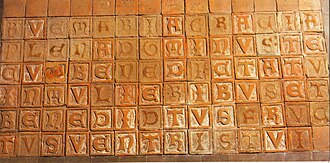Medieval letter tile
As medieval brick letters Einbuchstabensteine (are bricks , tiles , tiles and paving stones ) indicates that in monasteries and churches of the late Middle Ages were used for the production of sacred inscriptions. The decoration technique practiced particularly in the 13th and 14th centuries is similar to the method known today from the Scrabble board game : By lining up bricks, each showing a letter , any text could be created on walls or floors. The letters themselves were previously produced by pressing reversed stamps into the soft clay , which was then fired firmly.
The peculiarity of the process is that it is an early form of printing with movable letters , which, according to its principle, is nothing more than the stringing together of identical individual letters in the print image. In contrast to the printing technique later established by Johannes Gutenberg , the work sequence for the brick alphabets was reversed: printing was done first and only afterwards, when laying the letter tiles , was the setting process carried out when these were put together to form texts.
The use of movable single-letter bricks is among others. a. for the English Chertsey Abbey , in the ruins of which such cobblestones from the second half of the 13th century were recovered, and for the Aduard Monastery in the Netherlands, which is now also destroyed , whose flooring dates from the early 14th century. In the Zinna monastery south of Berlin, however, the text of an Ave Maria can still be found in the floor in front of the main altar. Each letter appears as a high relief impression on an unglazed, red-brown clay tile with a circumference of 14 × 14 cm. The Latin inscription dates from the 13th to 14th centuries and was written in Gothic capitals .
Individual evidence
- ↑ Brekle (1997), pp. 61f .; Lehmann-Haupt (1940), p. 97
- ↑ Brekle (1997), pp. 61f.
- ↑ Lehmann-Haupt (1940), p. 96f.
- ↑ Meijer (2004)
- ↑ Klamt (2004), pp. 195-210
literature
- Herbert E. Brekle : The typographical principle. Attempt to clarify terms , in: Gutenberg-Jahrbuch , Vol. 72, 1997, pp. 58–63 (61f.) ( PDF )
- Christian Klamt: Letters van baksteen in een cistercienzerklooster: het Ave Maria te Zinna , in: Stuip, REV (ed.): Meer dan muziek alleen: in memoriam Kees Vellekoop , Uitgeverij Verloren, Utrechtse bijdragen tot de mediëvistiek, vol. 20, Hilversum 2004, ISBN 90-6550-776-0 , pp. 195-210
- Hellmut Lehmann-Haupt : English wooden stamp alphabets of the XIII. Century , in: Gutenberg-Jahrbuch 1940, pp. 93–97
- Frank Meijer: De stenen letters van Aduard , 2nd edition, Omnia Uitgevers, Groningen 2004, ISBN 978-90-75354-08-9
further reading
- Loyd Haberley: Medieval English Paving Tiles , Blackwell 1937
